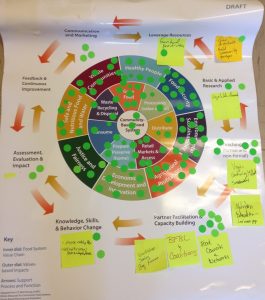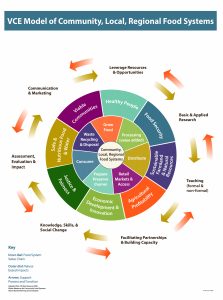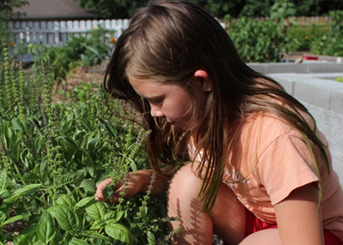Developing the VCE Model of Community, Local, and Regional Food Systems
By Joyce Latimer, Professor of Horticulture at Virginia Tech
Most great projects start with a model. Our model began as a draft concept that the VCE Community, Local, and Regional Food Systems (CLRFS) steering committee developed using a wide array of literature with a focus on the Whole Measures for Community Food Systems and the C.S Mott Group’s model for community-based food systems. After several iterations within our steering committee, we tested our model in an interactive mapping exercise conducted at the 2016 VCE CLRFS Forum held in Richmond VA. Our “mapping” activity launched the day’s event by way of setting up flip charts and questions for the participants to respond to as they entered the meeting room. Our goal was to generate feedback and shared learning about the kinds of work we do and the impacts we believe we have in our communities. These questions and prompts included:
Q1/flip chart: From your current work, what CLRFS-related issue or project are you most excited about?
Q2/flip chart: What one impact do you most hope to see come to light from your CLRFS-related work?
Q3/CLRFS Graphic: Where and how do you “do” the work?
The resulting graphic with dots and post-it notes not only shows how we work together across the food system through a number of support functions and processes, but it emphasizes where this work falls along the food system value chain. Lastly, this model emphasizes the value-based impacts that stem from a growing number of projects, programs, and research initiatives that cut across our departments, offices, and historical program areas in VCE.
The Steering Committee used feedback from the mapping exercise and the Forum participants to revise the model as shown below to use as a guide to organize our food systems work as we try to understand its breadth across the Commonwealth. We still consider our model a work in progress. For a printable copy of the model, visit http://www.pubs.ext.vt.edu/content/dam/pubs_ext_vt_edu/ALCE/ALCE-154/ALCE-154-PDF.pdf.



